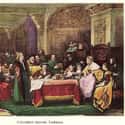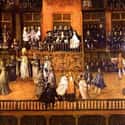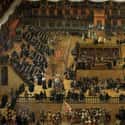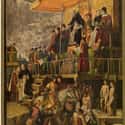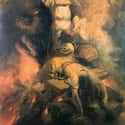-
(#7) It Was Both Religious And Political
Officially, the auto de fé was part of the Catholic Inquisition. Inquisitions were not civil affairs - they were handled by religious tribunals. At the same time, monarchical and governmental authorities played a part in the process. The Inquisition in Spain ramped up, for example, only when King Ferdinand and Queen Isabella were able to appoint their own Inquisitors and used them to challenge their political enemies.
Civil authorities also collaborated in the Inquisition process, and they would have been present at an auto de fé. Indeed, only civil authorities could condemn an accused person to be burned at the stake - the worst that religious officials could do was sentence someone to life in prison.
-
(#9) Prisoners Were Kept In The Dark About Their Fate Until The Auto De Fé
Secrecy was central to the Inquisition proceedings. This meant that prisoners would endure their trials only to have to wait longer to hear their fate. Often, they had to wait several days through the pomp and circumstance of the auto de fé to finally hear their sentence. Officials did this to limit the number of appeals higher courts might receive in the wake of trials. But waiting to hear their fate proved too excruciating for some, and there are records of prisoners committing suicide before hearing their sentencing.
-
(#1) It Was People's Favorite Form Of Theater
The auto de fé was the final stage of Inquisition proceedings. Though secrecy was paramount to the Inquisition trial stages leading up to the auto de fé, that was all abandoned on the day of the main event. Indeed, it was a form of public spectacle in which crowds of people turned up in city squares to watch the sentencing and punishment get carried out. As the ritual continued into the 17th century, the theater and spectacle of the auto de fé became even more elaborate, and common folks would eagerly read (or listen to) accounts of autos de fé they might've missed.
-
(#13) Not Everyone Loved A Good Burning
By the 18th century, Europe was deep in the age known as the Enlightenment, a time when the values of tolerance and humanitarianism began to take root. But, progress wasn't universal; autos de fé persisted in many parts of Europe and its colonies into the 19th century. Voltaire, one of the leading figures of the French Enlightenment, was a fierce critic of autos de fé. He even satirized them in his anti-religious work Candide.
-
(#8) The Actual Public Ritual Could Last Hours
Though autos de fé often varied in size and scale, the most elaborate auto de fé spectacles were huge, public affairs. In Latin America, for example, these large-scale events took place over the course of several hours. Events would start the night before the spectacle, when a procession that included church officials and a choir marched through the streets. A second procession including civic officials and aristocrats happened the following morning. After the procession, spectators would utter an oath of loyalty, hear a sermon, and then watch the sentencing.
-
(#11) Despite Being A Test Of Catholic Faith, Many Victims Were Non-Catholics
The "act of faith" was specifically a mechanism to keep Catholics in line. But many of the victims of the auto de fé weren't actually even Catholic - autos de fé punished anyone who was labeled a "heretic." This included former Jews, Muslims, Protestants, as well as people who regarded religion with skepticism. In short, anyone who did not follow the Catholic Church's mandates and expectations was at risk of being brought before a tribunal and suffering through an auto de fé.
New Random Displays Display All By Ranking
About This Tool
Auto De Fe Atomic Portuguese is a public religious trial and confession ceremony in the Middle Ages. The Spanish Inquisition or the Portuguese Inquisition imposed penalties on pagans and heretics. In fact, most of the prisoners were executed by the secular authorities after the confession. The most common victims were former Jews and former Muslims who were apostates.
To understand the nature of the Inquisition, we must understand that the Middle Ages is indeed a backward era. The random tool explained 15 brutal facts about Auto De Fe that you never know, in the centuries that the Inquisition has existed, many improper trials have been conducted in the name of religion.
Our data comes from Ranker, If you want to participate in the ranking of items displayed on this page, please click here.










